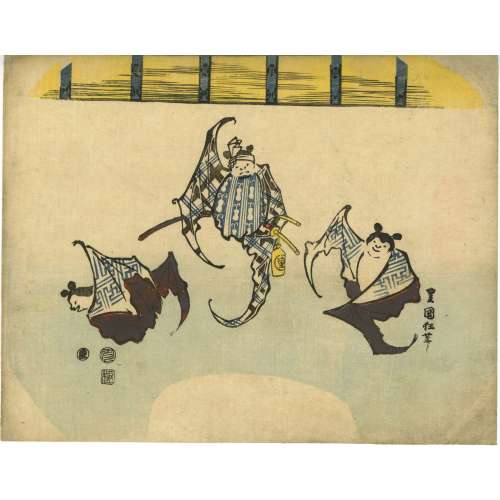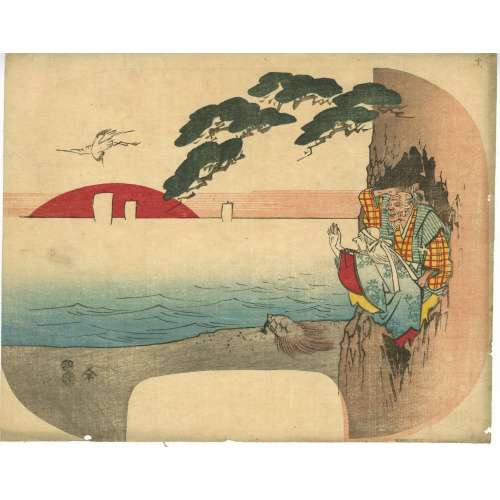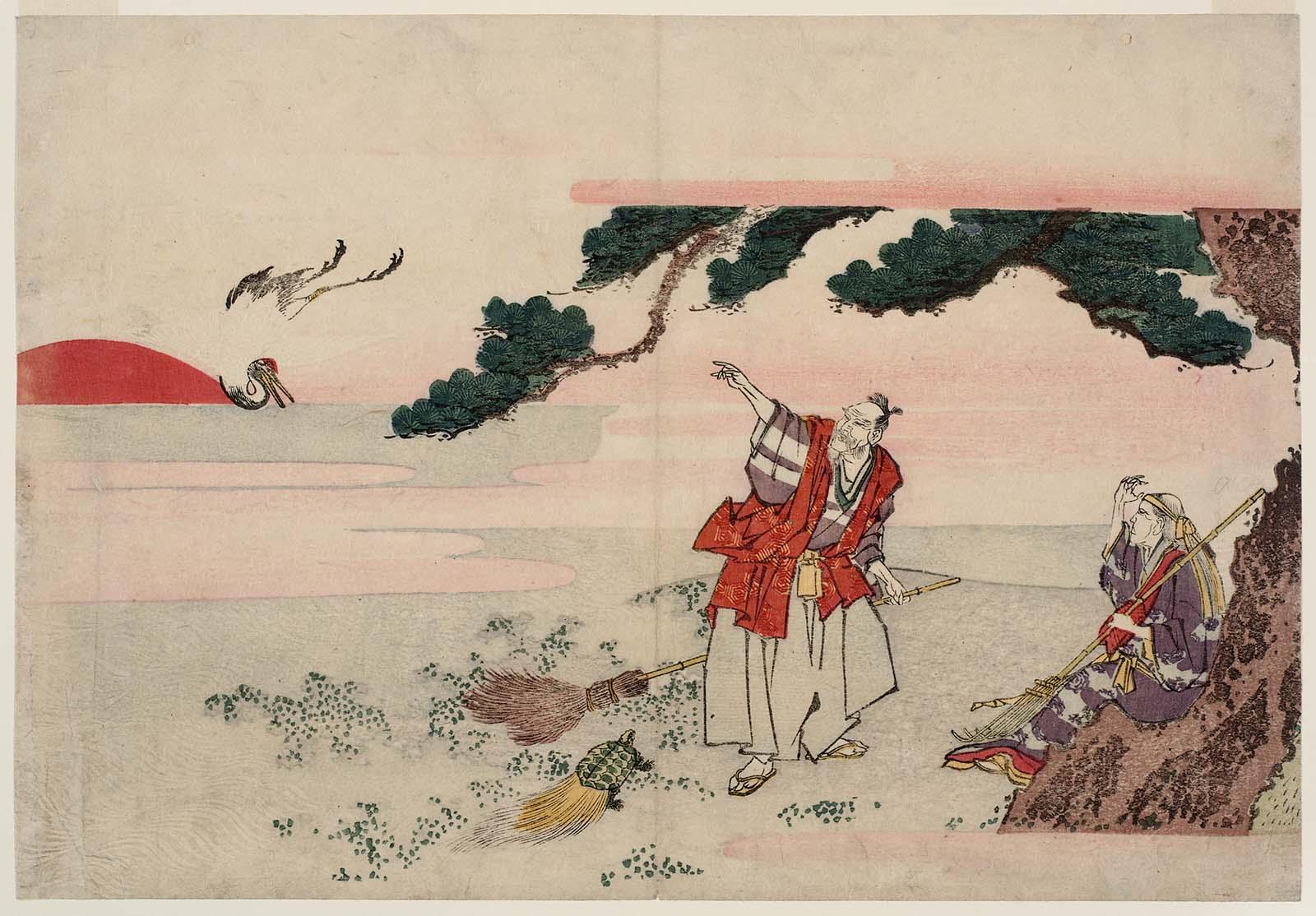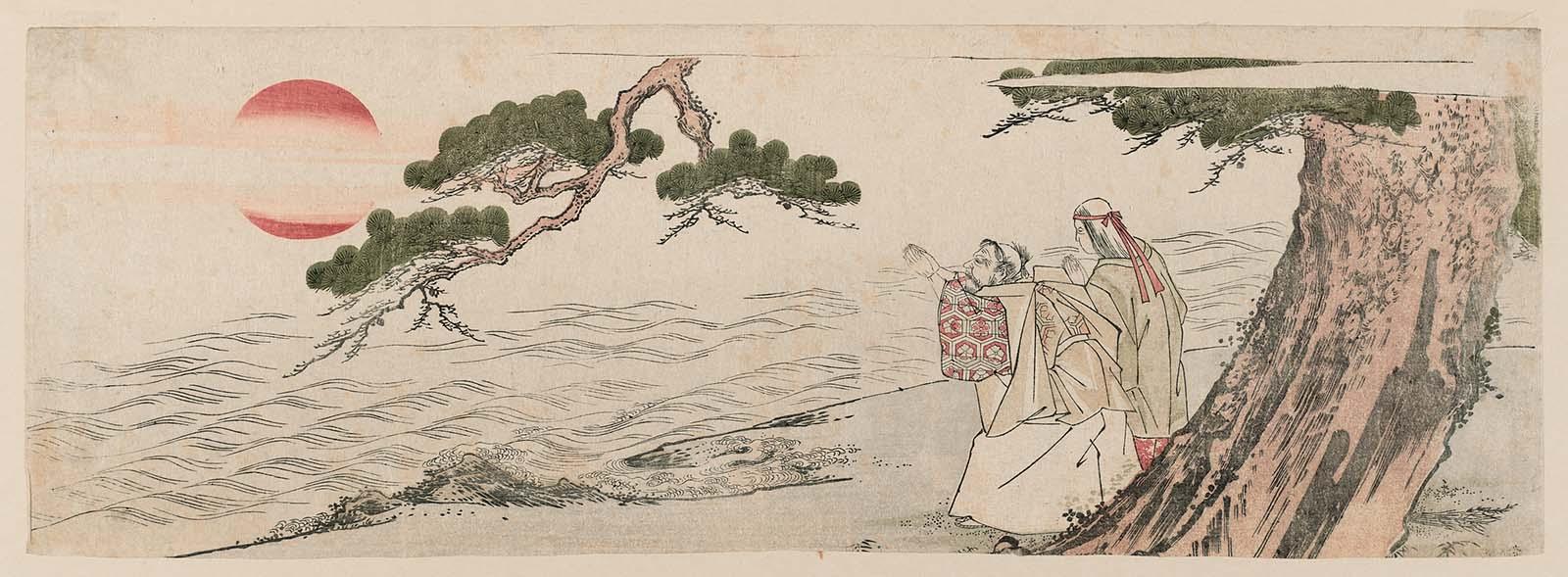-
 NEWArtist: Utagawa Kuniyoshi (歌川国芳) (1797–1861) Signed: 一勇斎 (Ichiyūsai) in a yellow cartouche, 國芳画 (Kuniyoshi ga) in a red cartouche Publisher: 未詳 (Yama-Ta), seal [板元, 太] – Hanmoto, Ta; Marks 19-044 | U421b Censor Seal: Aratame + Ansei 3 (3rd lunar month, 1856) Block Carver: 彫竹 (Hori Take), identified as Yokokawa Takejirō (横川竹二郎) (fl. 1845–1863) Media: Rigid fan print (Aiban Yoko-e Uchiwa-e, 合判横絵 団扇絵), 227 × 286 mm Half-length portrait of a high-ranking courtesan (oiran, 花魁) seated in a three-quarter view, holding a porcelain sake cup decorated with a blue mon of stylized oak leaves (kashiwa, 柏). She gazes downward at a partially unrolled letter resting on her lap. Her elaborate hairstyle, adorned with multiple kogai (ornamental hairpins) featuring golden floral motifs, signifies her elevated status within her profession. Her layered kimono displays a combination of red, blue, and black geometric patterns, emphasizing the luxurious textiles associated with courtesans of her rank. The stylized oak leaves on the sake cup may allude to the family mon of Onoe family of kabuki actors, evoking the overlap between theatre and the pleasure quarters. The background portrays a night scene in the Yoshiwara Pleasure District (吉原), where figures move beneath lantern-lit buildings, showing the vibrant nightlife of Edo.
NEWArtist: Utagawa Kuniyoshi (歌川国芳) (1797–1861) Signed: 一勇斎 (Ichiyūsai) in a yellow cartouche, 國芳画 (Kuniyoshi ga) in a red cartouche Publisher: 未詳 (Yama-Ta), seal [板元, 太] – Hanmoto, Ta; Marks 19-044 | U421b Censor Seal: Aratame + Ansei 3 (3rd lunar month, 1856) Block Carver: 彫竹 (Hori Take), identified as Yokokawa Takejirō (横川竹二郎) (fl. 1845–1863) Media: Rigid fan print (Aiban Yoko-e Uchiwa-e, 合判横絵 団扇絵), 227 × 286 mm Half-length portrait of a high-ranking courtesan (oiran, 花魁) seated in a three-quarter view, holding a porcelain sake cup decorated with a blue mon of stylized oak leaves (kashiwa, 柏). She gazes downward at a partially unrolled letter resting on her lap. Her elaborate hairstyle, adorned with multiple kogai (ornamental hairpins) featuring golden floral motifs, signifies her elevated status within her profession. Her layered kimono displays a combination of red, blue, and black geometric patterns, emphasizing the luxurious textiles associated with courtesans of her rank. The stylized oak leaves on the sake cup may allude to the family mon of Onoe family of kabuki actors, evoking the overlap between theatre and the pleasure quarters. The background portrays a night scene in the Yoshiwara Pleasure District (吉原), where figures move beneath lantern-lit buildings, showing the vibrant nightlife of Edo. -
 NEWArtist: Utagawa Toyokuni II [歌川豊国二代] a.k.a. Toyoshige [豊重] (Japanese, (1777 – 1835) Signed: 豊国狂筆 (Toyokuni kyō-hitsu, "mad brush of Toyokuni") Publisher: Maru-Jū (丸重), seal Jū (重), Marks reference 08-079 | U190a (1826–1829, only on fan prints) Censor Seal: Kiwame + Bunsei 12 (Year of the Ox [丑], 1829) Media: Uchiwa-e (fan print), color woodblock print, 230 × 293 mm
NEWArtist: Utagawa Toyokuni II [歌川豊国二代] a.k.a. Toyoshige [豊重] (Japanese, (1777 – 1835) Signed: 豊国狂筆 (Toyokuni kyō-hitsu, "mad brush of Toyokuni") Publisher: Maru-Jū (丸重), seal Jū (重), Marks reference 08-079 | U190a (1826–1829, only on fan prints) Censor Seal: Kiwame + Bunsei 12 (Year of the Ox [丑], 1829) Media: Uchiwa-e (fan print), color woodblock print, 230 × 293 mmA fantastical kabuki-themed scene depicting three anthropomorphic bats, dressed in Edo-period costumes. The central figure, likely Ichikawa Danjūrō VII (市川團十郎七, 1791–1859), is distinguished by his costume featuring a gourd motif (瓢箪, hyōtan)—a symbol closely linked to the Ichikawa family. He wears two swords, further identifying him as a kabuki hero, and carries a sake flask marked with what appears to be the publisher's emblem. His raised arm (or wing?) suggests a dramatic action, possibly striking or threatening the bat figure on the left, who recoils in response.
The two side bats, also dressed in patterned kimono, display expressions contrasting with the central figure—one appearing startled, while the other remains cheerful. The oxidized lead-orange pigment used in the lower portions of their wings suggests depth and texture.
This print reflects Danjūrō VII’s association with both the bat (蝙蝠, kōmori) and the double gourd. Bats were considered lucky symbols due to their resemblance to the character of "good fortune" (福, fuku), and Danjūrō VII often incorporated bat motifs into his stage costumes. The Ichikawa family's crest, the mimasu (三升, "three squares"), was more commonly used, but the double gourd and bat imagery appeared in promotional materials, reinforcing his theatrical identity. -
 NEWArtist: Attributed to Katsushika Hokusai (葛飾 北斎) (1760–1849) – unsigned. Publisher: Unknown, seal Hei (平); Marks 05-004 | U377a (1848) Censor Seal: Double nanushi Hama (濱) & Kunigasa (衣笠) Date: Kōka 4–5 / Kaei 1 (1847–1848) Media: Rigid fan print (Aiban Yoko-e Uchiwa-e, 合判横絵 団扇絵), 239 × 301 mm The legendary elderly couple Jō and Uba (尉と姥), spirits of the paired pines of Takasago (高砂) and Sumiyoshi (住吉), are known as the Aioi-no-Matsu (相生の松). They symbolize marital harmony, longevity, and the enduring bond of love. The Takasago legend is one of the oldest in Japanese mythology, famously portrayed in the Noh play Takasago no Uta (高砂の歌).
NEWArtist: Attributed to Katsushika Hokusai (葛飾 北斎) (1760–1849) – unsigned. Publisher: Unknown, seal Hei (平); Marks 05-004 | U377a (1848) Censor Seal: Double nanushi Hama (濱) & Kunigasa (衣笠) Date: Kōka 4–5 / Kaei 1 (1847–1848) Media: Rigid fan print (Aiban Yoko-e Uchiwa-e, 合判横絵 団扇絵), 239 × 301 mm The legendary elderly couple Jō and Uba (尉と姥), spirits of the paired pines of Takasago (高砂) and Sumiyoshi (住吉), are known as the Aioi-no-Matsu (相生の松). They symbolize marital harmony, longevity, and the enduring bond of love. The Takasago legend is one of the oldest in Japanese mythology, famously portrayed in the Noh play Takasago no Uta (高砂の歌).Aioi-no-Matsu – The Paired Pines of Takasago and Sumiyoshi
The Aioi-no-Matsu refers to two pine trees growing separately but intertwined at the roots, representing an unbreakable union.- The Takasago pine (高砂の松) grows in Harima Province, while the Sumiyoshi pine (住吉の松) stands in Settsu Province.
- Though physically distant, these trees are spiritually connected, like Jō and Uba, the aged couple who embody their spirits.
- The phrase "The wind that blows through Takasago reaches Sumiyoshi" symbolizes the continuity of love and harmony across time and space.
Aioi-no-Matsu in the Noh Play Takasago
The Noh play Takasago, attributed to Zeami, popularized this imagery.- Jō and Uba appear as an elderly couple raking pine needles, revealing themselves as the spirits of the Aioi-no-Matsu.
- The play conveys the theme of eternal harmony between husband and wife, making Aioi-no-Matsu a symbol of auspicious blessings for weddings and longevity celebrations.
Symbolism in the Print
This print incorporates traditional symbols of longevity and prosperity:- A minogame (蓑亀, "straw-cloaked turtle"), representing immortality, rests near the shore.
- A crane (鶴, tsuru), a symbol of marital fidelity.
- The rising sun over the ocean represents renewal and hope for the coming year.
- Jō and Uba’s presence under the Aioi-no-Matsu (Paired Pines) evokes the traditional New Year’s wish for long life and unity.
- The minogame and crane further reinforce New Year’s themes of prosperity and fortune.
Comparison to MFA Boston Prints
This print shares strong visual and thematic connections with two works attributed to Hokusai in the MFA Boston collection:- Accession No. 21.10269 – "Jō and Uba, the Spirits of the Pine Trees of Takasago and Sumiyoshi"
- Depicts the couple sweeping pine needles, reinforcing themes of domestic harmony and renewal.
- Includes a minogame and a flying crane, similar to this print.
- Accession No. 21.7869 – Another version of "Jō and Uba"
- Shows Jō and Uba standing, gazing at the sea, in a more expansive composition.
- Features a large pine tree, crashing waves, and a red sun, mirroring the background elements in this print.

MFA-B № 21.10269

MFA-B № 21.7869
-
 NEWArtist: Utagawa Kuniyoshi (歌川国芳) (1797–1861) Signed: Ichiyūsai Kuniyoshi ga [一勇斎 國芳画] in red cartouche Date: VI/1842 – V ic/1846, single nanushi censor seal Murata (村) for censor Murata Sahei [村田佐兵衛]. Publisher: Unknown, Izuzen (Bei, 米); Marks 06-028 | U103a Media: Rigid fan print (Aiban Yoko-e Uchiwa-e, 合判横絵 団扇絵), 224 x 290 mm
NEWArtist: Utagawa Kuniyoshi (歌川国芳) (1797–1861) Signed: Ichiyūsai Kuniyoshi ga [一勇斎 國芳画] in red cartouche Date: VI/1842 – V ic/1846, single nanushi censor seal Murata (村) for censor Murata Sahei [村田佐兵衛]. Publisher: Unknown, Izuzen (Bei, 米); Marks 06-028 | U103a Media: Rigid fan print (Aiban Yoko-e Uchiwa-e, 合判横絵 団扇絵), 224 x 290 mmHalf-length portrait of a woman facing slightly to the right. She wears a patterned kimono with multiple floral and seasonal motifs, including uchiwa (round fans), plum blossoms, maple leaves, chrysanthemums, snow-covered bamboo, pine branches, and peonies. Her obi is tied in front, and a red collar is visible beneath the layers. Her hair is arranged in an elaborate updo and is adorned with a hairpin featuring a rabbit and a crescent moon, referencing lunar symbolism. She dedicates a hand towel at a washing trough (手水舎, temizuya) in a shrine. Inscriptions on the towels.
In the background, several towels are hanging, featuring various mon (family crests) and symbols:
- Three oak leaves
- Crossed or intersecting hawk feathers
- Kiri-mon (Paulownia crest, associated with Kuniyoshi)
- Toshidama (seal of the Utagawa school)
- Masu (枡, measuring box) motif – a square with diagonal lines
- Kuniyoshi Project
- [LIB-3428.2025] Christie’s, New York: Japanese Prints, Paintings, and Screens, Monday, 24 November 1997 / Sales Catalogue, № 130, p. 63.


